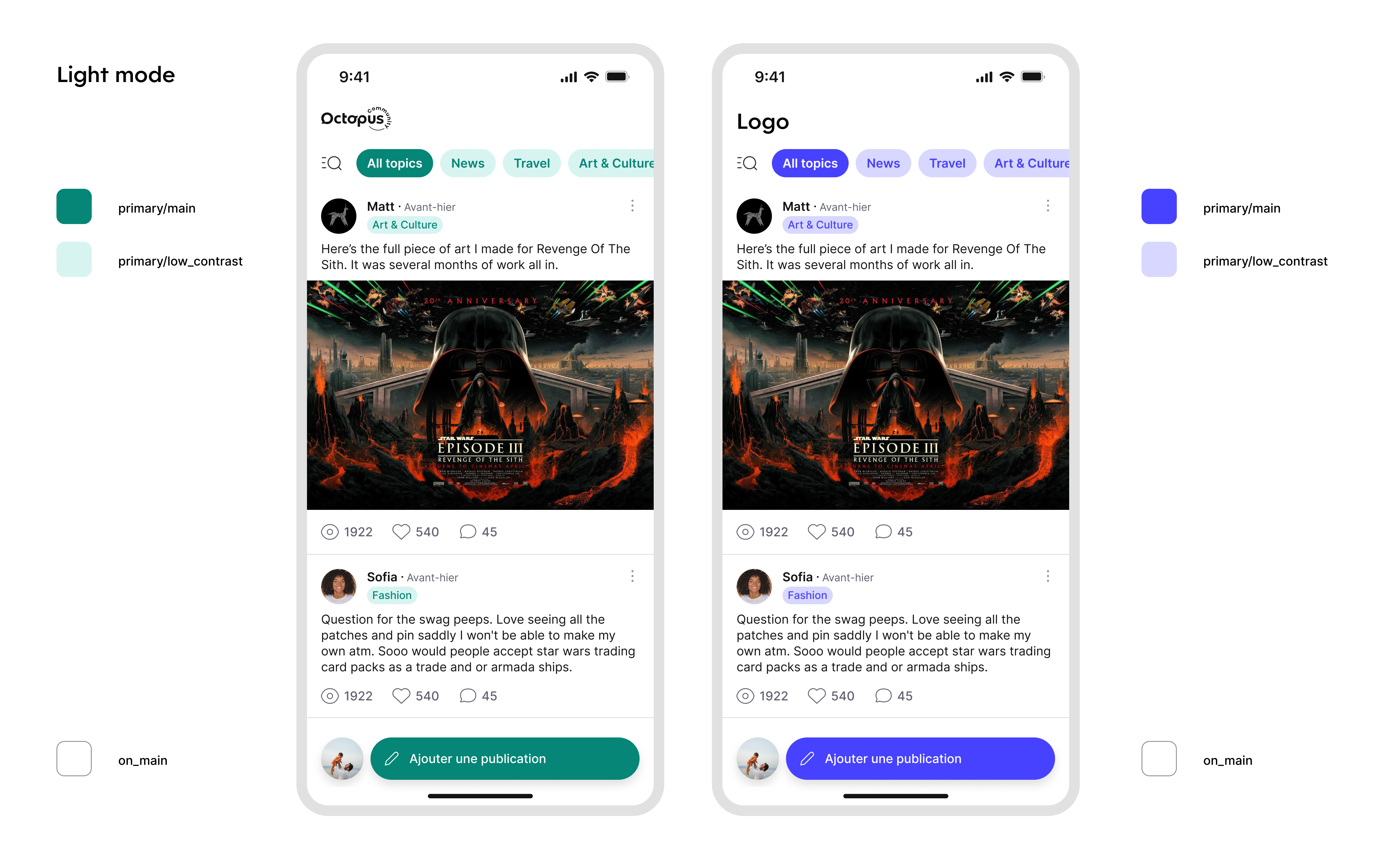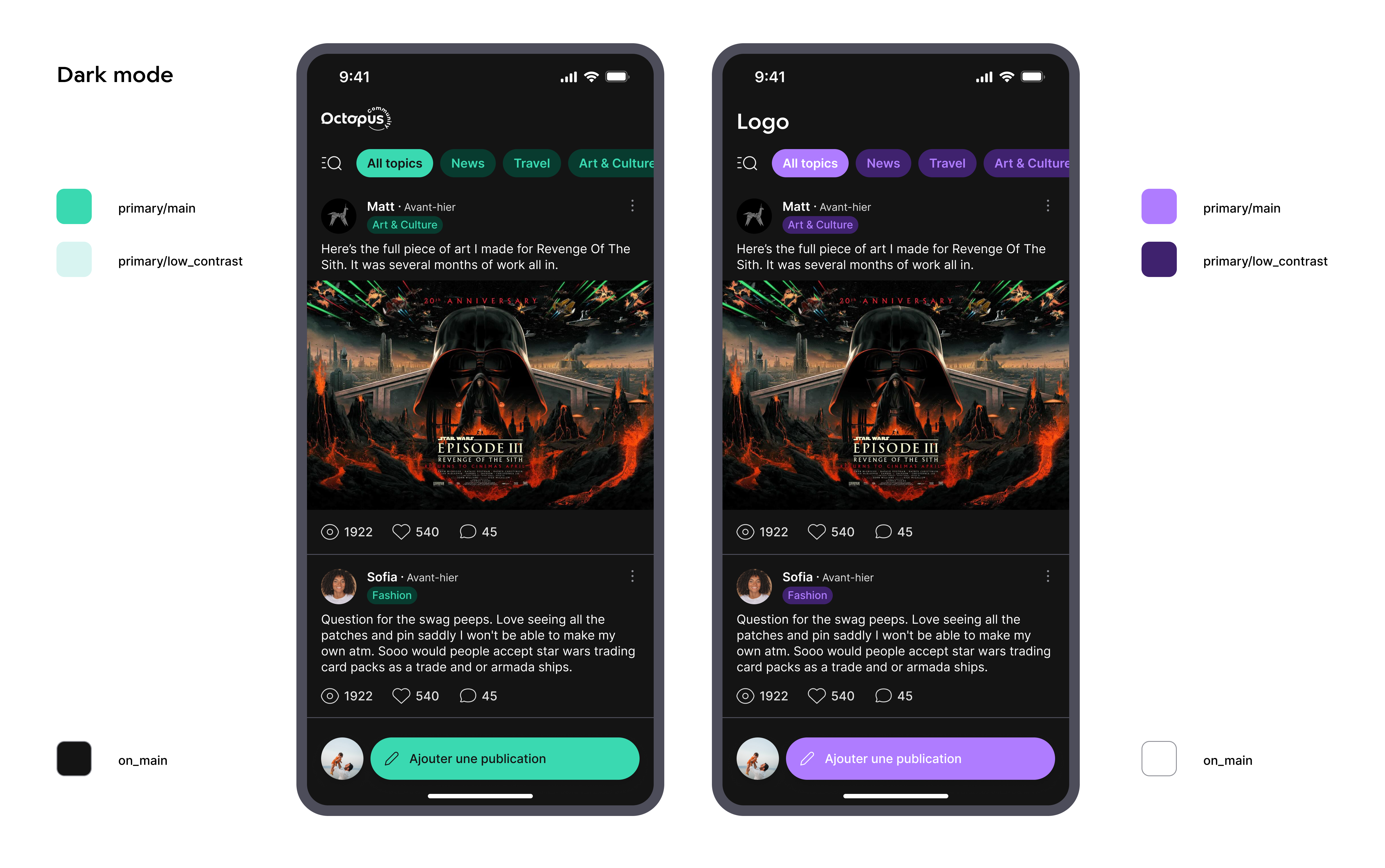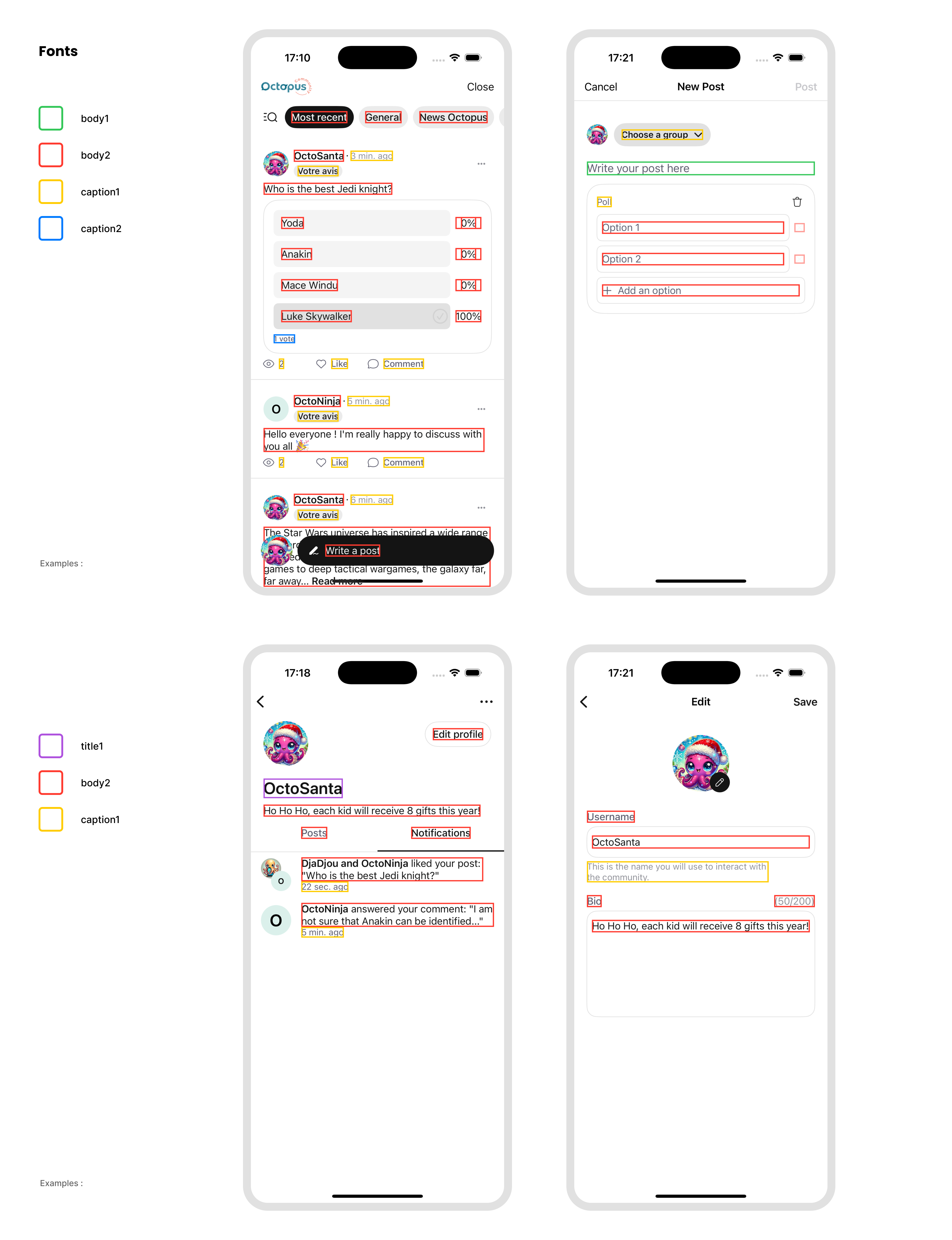iOS SDK Setup Guide With Octopus Authentication
Install the SDK
Octopus can be installed:
In an Xcode project
Open your workspace (.xcworkspace) or your project (.xcodeproj), open the File menu and open Add Package Dependencies. Then, paste the url of the Octopus Community SDK:
https://github.com/Octopus-Community/octopus-sdk-swift.git
On the next window, add both Octopus and OctopusUI to your target.
OR
In a Swift Package
Add the dependency to your package:
dependencies: [
.package(url: "https://github.com/Octopus-Community/octopus-sdk-swift.git", from: "1.0.0"),
],
Add the SDK as a dependency to your target:
.target(
name: "YourTarget",
dependencies: [
.product(name: "Octopus", package: "octopus-sdk-swift"),
.product(name: "OctopusUI", package: "octopus-sdk-swift"),
]
),
Not recommended: Cocoapods
As CocoaPods is starting to be less and less used, some libraries are not available anymore. This is the case of SwiftGrpc on which the Octopus SDK has built its backend exchanges. Hence, if you use the SDK using Cocoapods, you will be using an old version of SwiftGrpc.
If you really have to use the SDK with Cocoapods, here is how to do it:
- Copy the content of our podfile example in your podfile. Pay attention to the fact that the post_install script is setting iOS 14 as minimum requirement and setting
ENABLE_USER_SCRIPT_SANDBOXINGtoNO. - Then you can run
pod install
See the Octopus SDK GitHub Release section to get the latest published version.
Use the SDK
As early as possible in your code, you should initialize the OctopusSDK object.
This object is expecting two things:
- the Octopus Community API key
- the connection mode
You are reading the Octopus Authentication connection mode documentation, if your community is configured to use SSO, please open the documentation for this mode.
First, import Octopus:
import Octopus
Then, create and hold the Octopus SDK:
let octopus = try OctopusSDK(
apiKey: "YOUR_API_KEY")
Deeplink to your app
If you want to enhance the user experience, Octopus SDK lets you pass a deep link that will be called right after that the user has opened the magic link. This means that when you pass a deeplink, your app will be immediatly put in foreground, keeping your users focused on what they were doing before the connection.
To do that, simply create the SDK this way:
let octopus = try OctopusSDK(
apiKey: "YOUR_API_KEY",
connectionMode: .octopus(deepLink: "YOUR_DEEPLINK")
)
You also have to register the URL scheme included in YOUR_DEEPLINK. See the Apple documentation to know more about it.
Display the Octopus Community UI
Now that you have the SDK properly configured, you can add a button in your app that opens the Octopus Community UI.
First import Octopus UI
import OctopusUI
Octopus handles its own navigation, so you must not embed it in a navigation stack.
@State private var openOctopus = false
var body: some View {
Button("Open Octopus Community") {
openOctopus = true
}.fullScreenCover(isPresented: $openOctopus) {
OctopusHomeScreen(octopus: octopus)
}
}
If your using a UITabBarController to display the Octopus UI inside a UIHostingController, you might encounter a safe area bug. This is a known bug not related to the Octopus SDK UI. To fix it, you might want to add the UITabBarController children in the code instead of in the Storyboard. Otherwise, you can add a negative padding equal to tabbarcontroller.tabBar.frame.size.height to the OctopusUI.
Main screen's navigation bar
You can customize the look of the navigation bar in the main screen (the posts list).
There are two params when displaying the OctopusHomeScreen that have an effect on this navigation bar:
navBarLeadingItem: it is an enum value that lets you chose what will be displayed in the top left corner.
Its value is either:.logoto display the logo (see Modify the theme).text(TextTitle)to display a text. In the case of a text, we highly encourage you to chose it small (less than 18 characters). Default value is.logo.
navBarPrimaryColor: iftrue, the background color of the navigation bar will be set to the primary color (see Modify the theme). Otherwise, it will be the default color. Default value isfalse.
Here is how to use these two parameters:
OctopusHomeScreen(
octopus: octopus,
navBarLeadingItem: .text(.init(text: "App Name")),
navBarPrimaryColor: true
)
To see a full example of how you can achieve that, you can follow how it is done in the Samples, in the Scenario "Custom theme".
Modify the theme
The Octopus SDK lets you modify its theme so its UI looks more like yours.
You can modify:
- the colors:
- the primary colors (a main color, a low contrast and a high contrast variations of the main color). Please note that the high contrast variation of the primary color is not used for the moment. If you do not pass a custom value for it, black/white default values will be used.
- the color of the elements (mostly texts) displayed over the primary color. If you do not pass a custom value for it, white/black default value will be used.
- the fonts. You can customize the styles (title1, body2, caption1...) used in the sdk. If you do not pass a custom value for it, default value will be used.
- the logo. This is an image displayed on the Octopus home page and profile creation view. If you do not pass a custom image for it, Octopus logo value will be used.
To do that, you can override the theme by passing it as environment object:
OctopusHomeScreen(octopus: octopus)
.environment(
\.octopusTheme,
OctopusTheme(
colors: .init(
primarySet: OctopusTheme.Colors.ColorSet(
main: yourPrimaryColor,
lowContrast: lowContrastVersionOfYourPrimaryColor,
highContrast: highContrastVersionOfYourPrimaryColor),
onPrimary: contentOverPrimaryColor),
fonts: .init(
title1: Font.custom("Courier New", size: 26),
title2: Font.custom("Courier New", size: 20),
body1: Font.custom("Courier New", size: 17),
body2: Font.custom("Courier New", size: 14),
caption1: Font.custom("Courier New", size: 12),
caption2: Font.custom("Courier New", size: 10),
navBarItem: Font.custom("Courier New", size: 17)
),
assets: .init(logo: yourLogoAsUIImage)
)
)
All parameters of the Theme have default values. Only override the ones that you want to customize. On the following example, you are creating an OctopusTheme with default colors, default fonts except for the title1 and a custom logo:
let octopusTheme = OctopusTheme(
fonts: .init(
title1: Font.custom("Courier New", size: 26)
),
assets: .init(logo: yourLogoAsUIImage))
Here is a summary of the impacts of the theme you choose:


Here is a summary of the text styles used in the main screens of the SDK:

If your app supports only light or dark mode, add to your Info.plist UIUserInterfaceStyle with the value Light or Dark to force the sdk to use the mode you specified.
Push Notifications ≥ 1.4.0
To increase user engagement, you can provide informations to the Octopus SDK so your users can receive push notifications when other users interact with them inside the community.
Octopus SDK is not asking for push notification permissions, we let you handle that part where it makes more sense in your app.
If your app does not support Push Notifications yet, you can follow the official Apple documentation.
Our servers need to have a key in the .p8 format in order to send push notifications to your app on your behalf
If you don't have this key yet, follow this tutorial
- Go to the Apple Dev Website and create a new key.
- Name it and check
Apple Push Notifications service (APNs) - Click on configure of this line and select
Sandbox & Productionin theEnvironmentmenu if you intend to have the same key for sandbox and production builds. - Download the key and be sure to store it in a secured and retrievable place
Once you have that file, you should send it using the secure form provided by the Octopus Team, along with:
- the key ID: can be found in the list of keys on the Apple Dev Website
- your Bundle ID: can be found in your Xcode project
- your Team ID: can be found here in the
Membership detailscard
Once your project is correctly setup for push notifications, you should forward the notification device token to the Octopus SDK:
func application(_ application: UIApplication, didRegisterForRemoteNotificationsWithDeviceToken deviceToken: Data) {
let token = deviceToken.map { String(format: "%02.2hhx", $0) }.joined()
octopus.set(notificationDeviceToken: token)
}
You are in charge of registering for remote notifications by calling
UIApplication.shared.registerForRemoteNotifications()
and for getting the user's authorizations by calling
notifCenter.requestAuthorization(options: [.alert, .badge, .sound])
When you receive a notification response (i.e. when the user tapped a notification), first check if it is an Octopus notification by calling:
OctopusSDK.isAnOctopusNotification(notification: notificationResponse.notification)
If it is one, display the Octopus UI and pass it the notification response as a Binding:
OctopusHomeScreen(octopus: octopus, notificationResponse: $octopusNotification)
Not seen notifications ≥ 1.3.0
To increase user engagement, let your users know that they have new notifications from the Octopus notification center. Displaying a badge with the number of new notifications in your app can be a great way to suggest your users to look at what's new in the community again.
To do that, the Octopus SDK exposes a @Published var notSeenNotificationsCount: Int.
If you want to update this value with the latest count, simply call :
try await octopus.updateNotSeenNotificationsCount()
To see a full example of how you can achieve that, you can follow how it is done in the Samples, in the Scenario "Notification Badge".
Analytics
Octopus Community provides analytics to help you better understand your users' behavior within the community. To improve the quality of these analytics, we offer features that allow you to provide additional information about your users.
Custom events ≥ 1.4.0
You can tell the SDK to register a custom event. This event can be merged into the reports we provide.
try await viewModel.octopus?.track(customEvent: CustomEvent(
name: "Purchase",
properties: [
"price": .init(value: "\(String(format: "%.2f", 1.99))"),
"currency": .init(value: "EUR"),
"product_id": .init(value: "product1"),
]))
To see a full example of how you can achieve that, you can follow how it is done in the Samples, in the Scenario "Custom events".
Community Visibility ≥ 1.3.0
If you enable access to the community for only a subset of your users and want the analytics we provide to take this into account, you can inform the SDK accordingly.
This information is reset at each SDK launch so be sure to call the function everytime and as soon as possible after SDK init.
This section is only usefull when the host app (i.e. your app) manages its own A/B testing logic. Call this if your app is running its own A/B test and you want Octopus to log whether a given user is in the "community-enabled" or "control" group. This is useful for reporting and engagement analytics, but does not change the SDK’s runtime behavior.
octopus.track(hasAccessToCommunity: canAccessCommunity)
Depreacted < 1.6.0
octopus.set(hasAccessToCommunity: canAccessCommunity)
To see a full example of how you can achieve that, you can follow how it is done in the Samples, in the Scenario "Track A/B Tests".
Bridges ≥ 1.5.0
Octopus provides a way to create posts that reference your own content — we call this a bridge. To create a bridge, your content (an article, a product, etc.) must have a unique identifier. This ID will be used to link your content to the post. It will also allow users in the Octopus Community to directly view your content.
We recommend adding a button in your app that encourages users to talk about your content.
The bridge process involves three main steps:
Step 1: Prepare the post data Use the SDK to get (or create) the ID of the post related to your content.
- First get from the SDK the id of the post to display. The SDK will create the post if it is not already created. To do that, call the dedicated API and pass the required data:
- Content id (called clientObjectId) that the post will be about
- Title of the post. It must be between 10 and 3000 characters..
- Catchphrase (optional). It will be displayed below the title, in bold. You can use something like "What do you think about this?". It must be less than 84 characters and we recommand between 6 and 38 characters.
- Image for the post (optional). You can either pass a remote image using an URL or a local image.
The image must respect these requirements:
- File size must be less than 50Mb
- File format must be jpg or png
- Image sides must be between 50px and 4000px, with a max ratio of 32:9 (bigger side / smaller side)
- If you pass a remote image, the resource should be public
- Text of the button that will invite your users to display your content (optionnal). You can use something like "Buy it" if your content is a purchasable product, or "Read the article" if it is a press article. When the button containing this text will be tapped, the SDK will ask you to display your content. If no text is provided, the button won't be displayed. It must be less than 28 characters, we recommand between 4 and 28 characters.
- Topic id (optional). This is the id of the topic that you want the post to be labelled with. If not provided, the topic will be automatically set according to your community settings. You can retrieve the list of the available topics with the dedicated API (see below).
- Signature (optional). For security reasons, to ensure that the request is coming from you, you can provide a signature. The need for the signature is based on your community settings, we highly encourage you to enable this security check by contacting us. Therefore, you must add a route like
/generateBridgeSignatureto your backend to generate this token based on the same algorithm as generating the token for users (subis not required for this process).
Step 2: Get the post ID
Calling the API with the previously created post data will return a post ID. With this ID, you can display the post using the Octopus UI. If the post is not created, this API will create it, otherwise it won't change its content.
Step 3: Handle user interaction
Optionally, you can register a callback to be notified when a user wants to view your content from a bridge post. The SDK will provide the clientObjectId so you can open the appropriate content.
Let's see how to do it with an example of a recipe app:
Prepare the ClientPost:
let postContent = ClientPost(
clientObjectId: "recipe-129302938", // a unique identifier for your content
topicId: foodRecipeId, // the id of the Octopus topic. Nil if default.
text: "The perfects Canelés", // between 10 and 3000 chars
catchPhrase: "Tried the canelés? Tell us how good they were!", // Less than 84 characters
attachment: .localImage(image.jpegData(compressionQuality: 1)!), // you can also pass .distantImage(url)
viewClientObjectButtonText: "Read the recipe", // Less than 28 characters, not displayed if you did not set any `displayClientObjectCallback`
signature: token
)
Then get the post id for this recipe:
let postId = try await octopus.getOrCreateClientObjectRelatedPostId(content: postContent)
To retrieve available topics:
// Get cached topics
octopus.$topics
.sink { topics in
// List of available topics
}
// Fetch latest topics from server
octopus.fetchTopics()
Register a callback to know when a user want to see your content from within the Octopus Community UI:
octopus.set(displayClientObjectCallback: { objectId in
// display the content that has the given objectId
})
Note that if you don't set the displayClientObjectCallback, the button containing the viewClientObjectButtonText you passed in the ClientPost won't be displayed.
To see a full example of how you can achieve that, you can follow how it is done in the Samples, in the Scenario "Bridge to Client Object". The RecipeViewModel is in charge of preparing the client post and getting the post id and the BridgeToClientObjectViewModel is in charge of setting the callback.
Octopus A/B Testing ≥ 1.6.0
The A/B test feature lets you measure the impact of the community on your app usage by splitting your audience into two cohorts:
- Test group: a portion of users (e.g., 30%) with full access to the community.
- Control group: the remaining users (e.g., 70%) without access. For them, when they tap the community button, Octopus displays a screen: “The community is not available yet for you, please come back later.” In Octopus Analytics, you’ll then see clear comparisons between these two cohorts in terms of app session volume and retention.
Even if this A/B Test is totally internal, we let you override the group assigned to the connected user. This can be useful during your tests to check what will see the users of each group or even to provide or disable access to some given users.
Use this method when you need to guarantee that the user’s community access is enforced by Octopus, regardless of internal A/B testing rules.
octopus.overrideCommunityAccess(canAccessCommunity)
To see a full example of how you can achieve that, you can follow how it is done in the Samples, in the Scenario "Force Octopus A/B Tests Cohort".
Follow the Samples
Want to see a code examples on how to use the SDK, no worries, we have that for you!
-
First, clone or download the code (SDK+Sample are placed on the same git repository):
-
Rename the
secrets.placeholder.xcconfigassecrets.xcconfig -
In
secrets.xcconfig, replaceYOUR_API_KEYwith your own API key and replaceYOUR_CLIENT_USER_TOKEN_SECRETwith your own token secret. -
Modify the function
initializeSDKof the OctopusSDKProvider class to uncomment only theinitializeSdk...function that fits your community configuration. -
Then run the Sample App